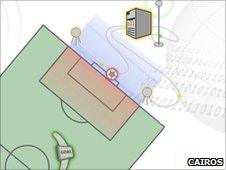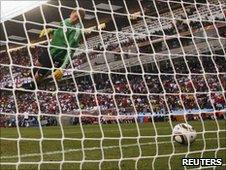Goal-line technology firms dispute Fifa claims
- Published
Manufacturers of ball-tracking systems say England's disallowed World Cup goal underlines the need for goal-line technology (GLT).
Hawk-Eye and Cairos, who make rival GLT systems, say Fifa needs to rethink its current position.
"We are using technology that is 100% accurate and adds fairness to the game," Christian Holzer of Cairos told BBC News.
Fifa has consistently refused to entertain the idea of using GLT.
"Technology should not enter into the game. It was a clear statement made by the majority of the IFAB (International Football Association Board)," said Fifa general secretary Jerome Valcke in March.

GLT can use cameras or magnetic fields to detect the ball.
But not everyone agrees. There have been calls from players, managers and coaches for a number of years, prompted by a series of controversial refereeing decisions.
British based Hawk-Eye, which uses a camera detection system, and German firm Cairos, which utilises chip technology inside the ball, both say that new technology would assist referees and make their job easier.
"The decision was unfair to the English team. Had it gone 2-2 at half-time, it would have been a very different match," said Mr Holzer, managing director of Cairos.
The issue of GLT has dogged Fifa for more than a decade.
The "rules of football" are determined by the IFAB, which consists of eight voting members. England, Scotland, Wales and Northern Ireland each have one vote, with "the rest of the world" (ie the Fifa executive) holding the remaining four.
The Football Association of Wales and the Irish Football Association - in addition to the Fifa executive - have been opposed to GLT.
'Long-term issue'
David Davies, a former executive director of the Football Association, told BBC News that the English FA had been pressing Fifa for GLT for years.
"The reality is that English football has been in favour of GLT for over a decade, but found itself a lonely voice in the football world.
"Whether that situation will change as a result of events remains to be seen."

TV replays and press cameras clearly show the ball had crossed the line.
The two main rival systems have been used by other sports for some time.
Hawk-Eye - which uses a number of different cameras to track the ball - is now part of the adjudication process in both cricket and tennis.
First used during England and Pakistan's Test series in 2001, the technology is now an accepted part of the game to determine leg before wicket (LBW) calls.
Its use in tennis was prompted by controversy. Serena Williams was knocked out of the US Open in 2004. TV replays showed that some of the umpire calls were wrong and although the decisions were not reversed, the Hawk-Eye system was installed for use in 2006.
'Too expensive'
The team behind Hawk-Eye envisages six cameras installed round the goal for use in football. The cameras are programmed to recognise the ball as the "object of interest" as opposed to the goalkeeper or other players.
The cameras can then accurately detect if the ball passes across the line, sending a "beep" into the referee's radio should it be deemed to be a goal.
Fifa has raised a number of issues about GLT, saying the system is not accurate enough, is too expensive and would affect the "universality of the game", in that World Cup matches would not have the same rules as a Sunday League game in Bradford.
Tottenham boss Harry Redknapp said Sepp Blatter, president of Fifa, should be "embarrassed".
"In the modern world we've got technology - let's use it," he said.
Sponsorship
Paul Hawkins, who developed the Hawk-Eye system, told BBC News: "There is no question that it works and the game will be better for it.
"In terms of cost, just look at tennis. They have firms - such as Rolex - sponsoring their system. I have no doubt football teams will be able to do the same."
The other GLT system - the Cairos Chip-Ball - uses a different method. Instead of camera technology, the ball itself is fitted with a chip.
Mr Holzer told BBC News that this "chip in a ball" had no impact on the handling characteristics of play.
"The chip is right in the centre, in a very robust mounting.
"We've played hundreds of matches to see if it had any effect - including blind tests - and there was none," he said.
Cairos says that the total weight of the device is 15g. The Jabulani match ball used in this year's World Cup weighs between 420-445g.
"Fifa used our technology during the Fifa Club World Cup in 2007," said Mr Holzer
"We think that using this technology adds fairness to the game."
It is unlikely any change to the rules will be made before IFAB next convenes in spring 2011.
- Published23 June 2010